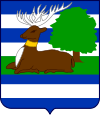Lovas, Croatia
| Lovas | |
|---|---|
| Municipality | |
 | |
  | |
 Lovas Location in Croatia | |
| Coordinates: 45°14′N 19°10′E / 45.233°N 19.167°ECoordinates: 45°14′N 19°10′E / 45.233°N 19.167°E | |
| Country |
|
| County |
|
| Population (2011)[1] | |
| • Total | 1,213 |
| Time zone | CET (UTC+1) |
| • Summer (DST) | CEST (UTC+2) |
| Postal code | ? |
| Area code(s) | 32 |
| Vehicle registration | VU |
| Website | lovas.hr |
Lovas is a village and seat of municipality in the Vukovar-Syrmia County of eastern Croatia, located on the slopes of Fruška Gora, a few kilometers south of the main road connecting Vukovar with Ilok. Lovas has a population of 1,167 (2001), and its municipality also includes the smaller village of Opatovac (pop. 412 in 2001) which is located to the north, at the Danube.
History
The village of Lowas in Feudal times was in the District of Vukovar a village belonging to the Eltz family. It was the home of Croats, Hungarians, Serbs, and Germans.
Recent history
Lovas was almost completely destroyed during the Croatian War of Independence when the villages were attacked by and later invaded by the Serbian forces. Lovas was a village of 1,681 at the time, mostly Croats (85.7%), with some Serbs (7.9%) and others (6.4%). Opatovac was populated by 550 people, of which there were 43.4% Croats, 26.2% Serbs, 21.1% Magyars, and 9.5% others.
In Lovas, 261 houses were completely destroyed, and all others were damaged, whereas in Opatovac, 15 homes were destroyed and fifty-odd others were damaged. Most of the damage was caused by Serbian bombing prior to the occupation, while some was caused afterwards.
Lovas was captured on October 10, 1991, and Opatovac on October 14. On October 11, a group of 51 Croats was forced to enter a mine field just outside Lovas in order to "clear" it, causing death to 21 of them and injury to another 14. Another 19 people were killed in the village the same day.
The Serbian army occupied a building in the village and used it as an improvised jail. There, the non-Serb population was mistreated to the extent of atrocity - men and women were arrested and subsequently beaten and molested with any and all instruments at their captors' disposal - from crowbars to knives to electrodes. Those Croats who remained were forced to wear white arm bands as a sign of racial recognition.
The Catholic church of St. Michael in Lovas, a 250-year-old building, was set on fire and later completely destroyed by explosives. The chapel of St. Florian at the Lovas graveyard was also set ablaze and devastated. The Catholic Church in Opatovac was pillaged and damaged. Later, in the center of Lovas, four adjacent family houses were unlawfully destroyed to make way for a new Orthodox church building.
The buildings of the Hrvatski dom (community house, lit. "Croatian home") and the municipality were also destroyed. Numerous private barns, warehouses and other buildings were destroyed, the "Borovo" factory was burned, the agricultural company "Lovas" immovable property (driers, silo) was destroyed as well, while the movable machines were stolen and transferred to Serbia. In Opatovac, the oil company INA's dispatch centre and the was badly damaged by rockets, as was the VUPIK plant Opatovac-Pustara.
A total of 1,661 people became refugees because of all this, of which 1,341 from Lovas and 320 from Opatovac. After the war, a mass grave was exhumed near the village cemetery, with 68 bodies, and another ten bodies were found in assorted graves around the village. These people were officially buried properly on March 21, 1998.
As a result of the war, a total of 83 villagers of Lovas lost their lives and four are still listed as missing. In Opatovac, two people are dead, and one is missing. After the war ended, almost two thirds of the Serbs moved out of the villages, reducing their number to 106. The number of Magyars was cut by almost one half as well (77). There are also 335 fewer Croats in the municipality.
References
- ↑ "Population by Age and Sex, by Settlements, 2011 Census: Lovas". Census of Population, Households and Dwellings 2011. Zagreb: Croatian Bureau of Statistics. December 2012.
External links
- Official web site (Croatian)
